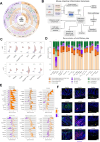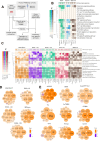Integrated multimodel analysis of intestinal inflammation exposes key molecular features of preclinical and clinical IBD
- PMID: 40301114
- PMCID: PMC12505074
- DOI: 10.1136/gutjnl-2024-333729
Integrated multimodel analysis of intestinal inflammation exposes key molecular features of preclinical and clinical IBD
Abstract
Background: IBD is a chronic inflammatory condition driven by complex genetic and immune interactions, yet preclinical models often fail to fully recapitulate all aspects of the human disease. A systematic comparison of commonly used IBD models is essential to identify conserved molecular mechanisms and improve translational relevance.
Objective: We performed a multimodel transcriptomic analysis of 13 widely used IBD mouse models to uncover coregulatory gene networks conserved between preclinical colitis/ileitis and human IBD and to define model-specific and conserved cellular, subcellular and molecular signatures.
Design: We employed comparative transcriptomic analyses with curated and a priori statistical correlative methods between mouse models versus IBD patient datasets at both bulk and single-cell levels.
Results: We identify IBD-related pathways, ontologies and cellular compositions that are translatable between mouse models and patient cohorts. We further describe a conserved core inflammatory signature of IBD-associated genes governing T-cell homing, innate immunity and epithelial barrier that translates into the new mouse gut Molecular Inflammation Score (mMIS). Moreover, specific mouse IBD models have distinct signatures for B-cell, T-cell and enteric neurons. We discover that transcriptomic relatedness of models is a function of the mode of induction, not the canonical immunotype (Th1/Th2/Th17). Moreover, the model compendium database is made available as a web explorer (http://trr241.hosting.rrze.uni-erlangen.de/SEPIA/).
Conclusion: This integrated multimodel approach provides a framework for systematically assessing the molecular landscape of intestinal inflammation. Our findings reveal conserved inflammatory circuits, refine model selection, offering a valuable resource for the IBD research community.
Keywords: CROHN'S DISEASE; IBD MODELS; INFLAMMATORY BOWEL DISEASE; ULCERATIVE COLITIS.
© Author(s) (or their employer(s)) 2025. Re-use permitted under CC BY. Published by BMJ Group.
Conflict of interest statement
Competing interests: None declared.
Figures






References
MeSH terms
LinkOut - more resources
Full Text Sources
Molecular Biology Databases
